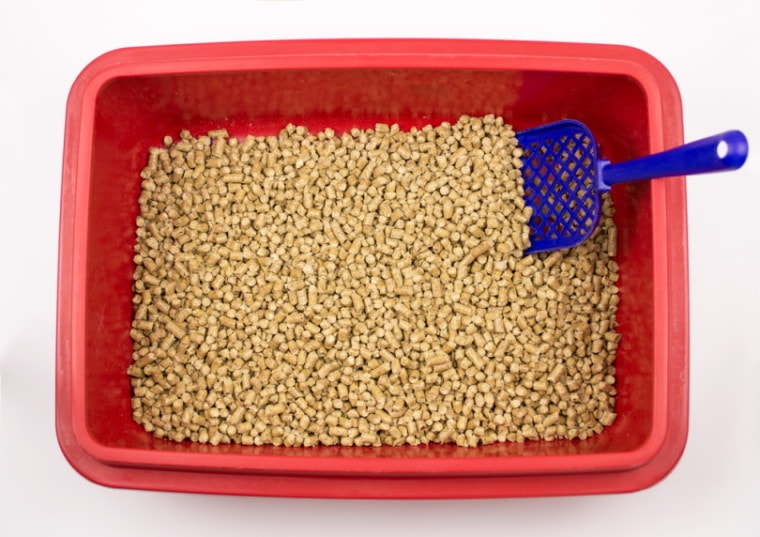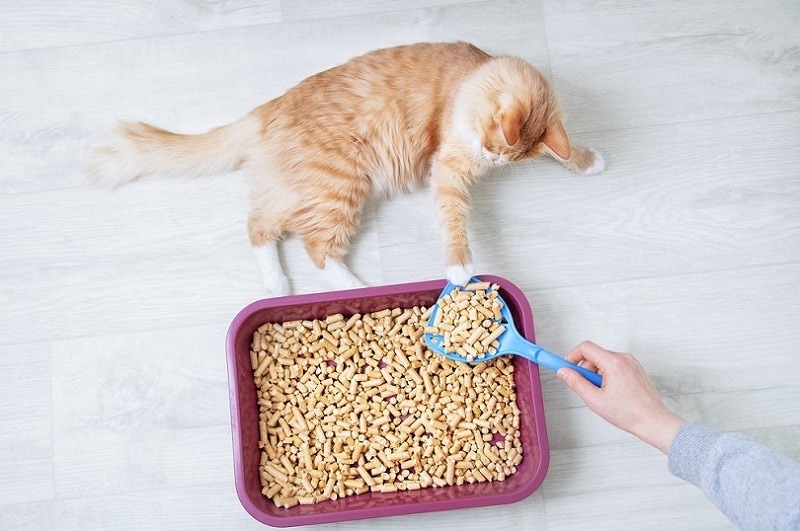
Cats have lived alongside humans for thousands of years. For most of that time, cats went where they lived and did what they pleased, their bathroom habits included!
Nowadays, cats are more domesticated than ever, with many being complete indoor cats. It may come as a surprise to you to know that in the grand scheme of the cat and human relationship timeline, cat litter has only been very recently invented.
So, where did this genius idea stem from? You may be surprised, that cat litter was invented by accident in 1947 by Edward Lowe.
Natural Instinct
Imagine the cat-astrophe of trying to train a cat to do something they don’t want to do! Lucky for us, cats instinctively use litter boxes when provided one. It means they are easy to litter box train even from a very young age.
Cats will excrete pheromones in their waste which are used as communication between each other. Dominant cats threatened by other cats in their territory will leave their feces uncovered to show dominance, while submissive cats will cover their feces to show they are submitting. While they may not act like it, your pet cat does recognize you as more dominant, so they will bury their waste in their litter box as not to offend you! How kind!
Cats burying their waste also has a significant evolutionary advantage. By covering up their feces, they mask the prominent scent that will lead predators to their location. This is particularly important for cats with nests of kittens that are vulnerable to be predation.
Intelligent cats were drawn to a soft substrate such as dirt and sand as it was easier to dig in to bury waste more effectively. That’s why our domesticated cats now are drawn to the litter box and know what to do when they feel the soft litter under their paws.

Indoor Cats
Cats continued this way for thousands of years, with the first resemblance of domesticated cats still residing outdoors with the world as their litter box. Cats started to live symbiotically with humans becoming excellent pest control in farms and factories. Over time we humans grew attached, and cats grew lazy and became household pets.
Indoor cats have become more common, with owners recognizing the dangers and risks to outdoor cats and the effect domestic cat populations can have on local ecosystems.
The problem faced with cats living indoors with their human families is where do they bury their waste?
The First Litter Boxes
It wasn’t until the mid-1940s that inviting your cat indoors was more common. Many times, they would move in and out of the home and do most of their business outside. But if they needed to stay in the house, during bad weather perhaps, their owns would provide them with some rudimentary litter boxes.
These boxes were simply metal pans with paper, sand, dirt, or ashes in them. While they worked in the sense that the cats were drawn to dig in them, they did little to mask the scent of cat waste in the home. In addition, these substrates ended up making horrific messes in the house!

A Happy Accident
The creation of cat litter as we know it originated in a strange place. Edward Lowe worked in a family business that sold sand, coal, and clay. One day in 1947, his neighbor came into his yard and asked for some sand for her cat to use indoors. It was the middle of winter, and Lowe’s sandpile was frozen.
Lowe told her this, and his neighbor remained at his desk as if she expected him to solve her issue! The business had just received a free sample of a new kind of clay that Edward had stored in the back room as he had no interest in purchasing any.
To get rid of the stubborn neighbor, he gave her some of this clay and quickly forgot about the exchange. A few days later, she returned praising how great the clay was for her cat. The clay was made of fuller’s earth, which has a positively charged chemical structure, meaning it can absorb a lot of water and odors.
Soon, Lowe’s neighbor and all her friends were coming to ask after this clay for their cat’s bathroom tray, and Lowe saw an opportunity.

Kitty Litter Arms Race
Edward Lowe invested in creating the brand “Kitty Litter.” He attempted to sell it to the local pet store, who flat out refused as sand was much cheaper, calling his invention “dirt in a bag.” Lowe gave his Kitty Litter away to pet stores for free and drove around his county attending cat shows.
He cleaned everyone’s cat boxes at shows to earn a booth to display his product. Eventually, with persistence and determination, Lowe demonstrated the benefits of Kitty Litter, and it became a product no modern cat owner could be without.
Once the invention was out there, other companies were quick to jump aboard. Edward Lowe invested $4 million into research and business expansion to ensure he stays in front of the pack.
With some tight competition, he almost lost out to big businesses but managed to stay on top. When he retired and sold his company, it was worth $200 million. A true entrepreneur, his memory lives on in the Edward Lowe Foundation. Founded before his death in 1995, this foundation aims to support entrepreneurial spirit and stewardship.
Cat Litter as We Know It
Since the first commercial cat litters, the market has expanded exponentially. Clumping litter was the first big leap from traditional litter, making cleaning the litter box a breeze. Now you can find cat litter made from clay, silica, pine, walnut, wheat, and paper – just to name a very few!
Even medical-grade litters are designed to change color based on the pH of your cat’s urine, which can indicate kidney health!
Alongside the wide range of different litters, there is a range of accompanying litter boxes. Most incredibly, self-cleaning litter boxes! The cat litter industry is a large and varied one, but also one that had humble beginnings. Our cats continue to be spoilt for choice; there’s a perfect choice for every cat out there!
Featured Image Credit: Alla_vector, Shutterstock







